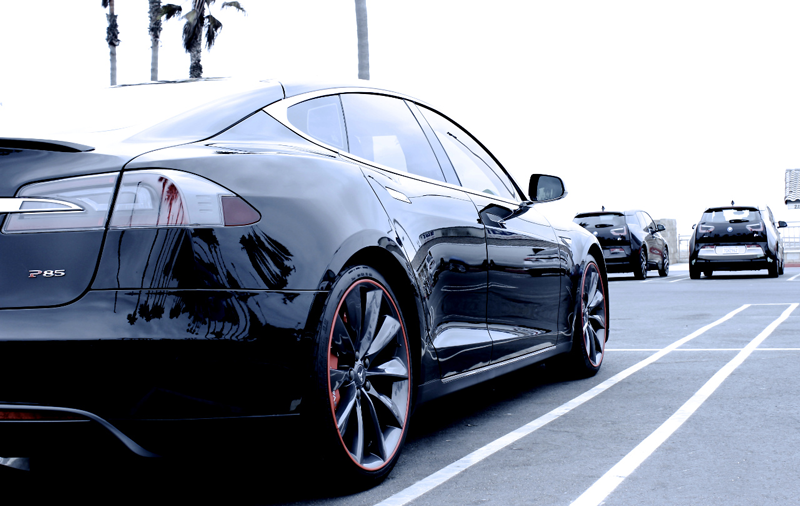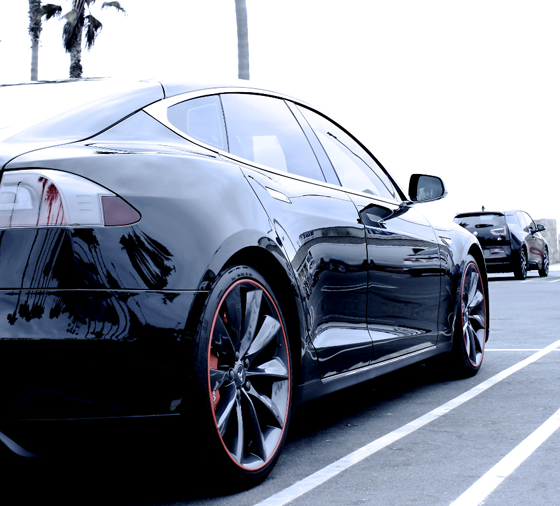

News
Pressures mount for BMW as Tesla continues to lead US large luxury car market
It’s a little early to predict that Tesla will drive the giant global automakers, one by one, into bankruptcy. However, there’s no question that some brands are already feeling the shockwaves from the electric automaker’s rise, especially in certain market segments.
Every automaker has its own mix of products, so the companies have varying degrees of exposure to the coming wave of disruption. As known Tesla bear Seeking Alpha argues, BMW could be in the most vulnerable position of all. Unlike the Big Three, BMW doesn’t sell pickup trucks, and unlike VW and the Asian carmakers, it doesn’t offer cheap entry-level runabouts (at least not in the US market). The Bavarian brand’s bread and butter consists of high-end sporty sedans and luxury SUVs – precisely the market segments in which Tesla is beginning to mop up the competition.
BMW’s troubles aren’t just theoretical – Seeking Alpha writer ValueAnalyst notes that sales of the company’s flagship sedan, the 7 Series (which BMW has produced since 1977), are in decline. As shown by tables from CarSalesBase.com, 7 Series sales jumped in 2016 after a redesign, but fell significantly in 2017. If current trends continue, yearly sales in the US for 2018 could see the lowest sales since 1992.
Tesla’s Model S has dominated the large luxury segment for a couple of years now, as a table from Statista makes clear. Tesla’s gains have come at the expense of legacy brands such as BMW and Mercedes, which has seen a year-to-date 15% drop in sales of its S Class.
 |
Above: Large luxury car sales in the United States in 2016, by key model in units (Source: Statista)
The news could get worse for the German sedan-meisters. According to SA’s ValueAnalyst, there are several indications that Tesla may be planning another redesign of Model S, and the latest specs for the upcoming Semi and Roadster make it sound as if battery improvements may be on the way too. When Model 3 comes into its own, it’s expected to offer stiff competition for BMW’s best-selling 3 Series. Considering all these factors, ValueAnalyst believes that “BMW can very well face an existential risk as early as 2018.”
In fact, in an earlier article entitled BMW Will Be the First to Go, ValueAnalyst characterized the company as “floundering in the face of severe competitive pressure and industry disruption.” BMW recently announced a $240-million investment in battery research, but that’s only a fraction of the billions that Tesla has invested over the last decade. “BMW may be years behind Tesla in battery technology.”
The company’s woes are not limited to competition from Tesla. Reuters recently reported that German prosecutors have begun an inquiry into allegations that BMW indulged in the same sort of diesel emissions shenanigans that have cost Volkswagen a few billion bucks. And BMW is in worse financial shape than VW was, with lots of debt and little cash on its balance sheet.
Taking it all into account, our Alpha Seeker expects BMW to be “the first traditional automaker to be significantly impacted by Tesla’s growth, as it has no segment that will not be under severe disruption by 2019.”
===
Note: Article originally published on evannex.com, by Charles Morris
Source: Seeking Alpha

Elon Musk
Elon Musk’s X will start using a Tesla-like software update strategy
The initiative seems designed to accelerate updates to the social media platform, while maintaining maximum transparency.

Elon Musk’s social media platform X will adopt a Tesla-esque approach to software updates for its algorithm.
The initiative seems designed to accelerate updates to the social media platform, while maintaining maximum transparency.
X’s updates to its updates
As per Musk in a post on X, the social media company will be making a new algorithm to determine what organic and advertising posts are recommended to users. These updates would then be repeated every four weeks.
“We will make the new 𝕏 algorithm, including all code used to determine what organic and advertising posts are recommended to users, open source in 7 days. This will be repeated every 4 weeks, with comprehensive developer notes, to help you understand what changed,” Musk wrote in his post.
The initiative somewhat mirrors Tesla’s over-the-air update model, where vehicle software is regularly refined and pushed to users with detailed release notes. This should allow users to better understand the details of X’s every update and foster a healthy feedback loop for the social media platform.
xAI and X
X, formerly Twitter, has been acquired by Elon Musk’s artificial intelligence startup, xAI last year. Since then, xAI has seen a rapid rise in valuation. Following the company’s the company’s upsized $20 billion Series E funding round, estimates now suggest that xAI is worth tens about $230 to $235 billion. That’s several times larger than Tesla when Elon Musk received his controversial 2018 CEO Performance Award.
As per xAI, the Series E funding round attracted a diverse group of investors, including Valor Equity Partners, Stepstone Group, Fidelity Management & Research Company, Qatar Investment Authority, MGX, and Baron Capital Group, among others. Strategic partners NVIDIA and Cisco Investments also continued support for building the world’s largest GPU clusters.
News
Tesla FSD Supervised wins MotorTrend’s Best Driver Assistance Award
The decision marks a notable reversal for the publication from prior years, with judges citing major real-world improvements that pushed Tesla’s latest FSD software ahead of every competing ADAS system.

Tesla’s Full Self-Driving (Supervised) system has been named the best driver-assistance technology on the market, earning top honors at the 2026 MotorTrend Best Tech Awards.
The decision marks a notable reversal for the publication from prior years, with judges citing major real-world improvements that pushed Tesla’s latest FSD software ahead of every competing ADAS system. And it wasn’t even close.
MotorTrend reverses course
MotorTrend awarded Tesla FSD (Supervised) its 2026 Best Tech Driver Assistance title after extensive testing of the latest v14 software. The publication acknowledged that it had previously criticized earlier versions of FSD for erratic behavior and near-miss incidents, ultimately favoring rivals such as GM’s Super Cruise in earlier evaluations.
According to MotorTrend, the newest iteration of FSD resolved many of those shortcomings. Testers said v14 showed far smoother behavior in complex urban scenarios, including unprotected left turns, traffic circles, emergency vehicles, and dense city streets. While the system still requires constant driver supervision, judges concluded that no other advanced driver-assistance system currently matches its breadth of capability.
Unlike rival systems that rely on combinations of cameras, radar, lidar, and mapped highways, Tesla’s FSD operates using a camera-only approach and is capable of driving on city streets, rural roads, and freeways. MotorTrend stated that pure utility, the ability to handle nearly all road types, ultimately separated FSD from competitors like Ford BlueCruise, GM Super Cruise, and BMW’s Highway Assistant.
High cost and high capability
MotorTrend also addressed FSD’s pricing, which remains significantly higher than rival systems. Tesla currently charges $8,000 for a one-time purchase or $99 per month for a subscription, compared with far lower upfront and subscription costs from other automakers. The publication noted that the premium is justified given FSD’s unmatched scope and continuous software evolution.
Safety remained a central focus of the evaluation. While testers reported collision-free operation over thousands of miles, they noted ongoing concerns around FSD’s configurable driving modes, including options that allow aggressive driving and speeds beyond posted limits. MotorTrend emphasized that, like all Level 2 systems, FSD still depends on a fully attentive human driver at all times.
Despite those caveats, the publication concluded that Tesla’s rapid software progress fundamentally reshaped the competitive landscape. For drivers seeking the most capable hands-on driver-assistance system available today, MotorTrend concluded Tesla FSD (Supervised) now stands alone at the top.
News
Elon Musk’s Grokipedia surges to 5.6M articles, almost 79% of English Wikipedia
The explosive growth marks a major milestone for the AI-powered online encyclopedia, which was launched by Elon Musk’s xAI just months ago.

Elon Musk’s Grokipedia has grown to an impressive 5,615,201 articles as of today, closing in on 79% of the English Wikipedia’s current total of 7,119,376 articles.
The explosive growth marks a major milestone for the AI-powered online encyclopedia, which was launched by Elon Musk’s xAI just months ago. Needless to say, it would only be a matter of time before Grokipedia exceeds English Wikipedia in sheer volume.
Grokipedia’s rapid growth
xAI’s vision for Grokipedia emphasizes neutrality, while Grok’s reasoning capabilities allow for fast drafting and fact-checking. When Elon Musk announced the initiative in late September 2025, he noted that Grokipedia would be an improvement to Wikipedia because it would be designed to avoid bias.
At the time, Musk noted that Grokipedia “is a necessary step towards the xAI goal of understanding the Universe.”
Grokipedia was launched in late October, and while xAI was careful to list it only as Version 0.1 at the time, the online encyclopedia immediately earned praise. Wikipedia co-founder Larry Sanger highlighted the project’s innovative approach, noting how it leverages AI to fill knowledge gaps and enable rapid updates. Netizens also observed how Grokipedia tends to present articles in a more objective manner compared to Wikipedia, which is edited by humans.
Elon Musk’s ambitious plans
With 5,615,201 total articles, Grokipedia has now grown to almost 79% of English Wikipedia’s article base. This is incredibly quick, though Grokipedia remains text-only for now. xAI, for its part, has now updated the online encyclopedia’s iteration to v0.2.
Elon Musk has shared bold ideas for Grokipedia, including sending a record of the entire knowledge base to space as part of xAI’s mission to preserve and expand human understanding. At some point, Musk stated that Grokipedia will be renamed to Encyclopedia Galactica, and it will be sent to the cosmos.
“When Grokipedia is good enough (long way to go), we will change the name to Encyclopedia Galactica. It will be an open source distillation of all knowledge, including audio, images and video. Join xAI to help build the sci-fi version of the Library of Alexandria!” Musk wrote, adding in a later post that “Copies will be etched in stone and sent to the Moon, Mars and beyond. This time, it will not be lost.”








